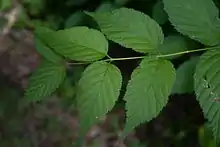Rhodotypos
Rhodotypos scandens, the sole species of the genus Rhodotypos, is a deciduous shrub in the family Rosaceae, closely related to Kerria and included in that genus by some botanists. It is native to China, Korea, possibly also Japan.
| Rhodotypos | |
|---|---|
 | |
| Scientific classification | |
| Kingdom: | Plantae |
| Clade: | Tracheophytes |
| Clade: | Angiosperms |
| Clade: | Eudicots |
| Clade: | Rosids |
| Order: | Rosales |
| Family: | Rosaceae |
| Subfamily: | Amygdaloideae |
| Tribe: | Kerrieae |
| Genus: | Rhodotypos Siebold & Zucc. |
| Species: | R. scandens |
| Binomial name | |
| Rhodotypos scandens | |
| Wikimedia Commons has media related to Rhodotypos scandens. |
Description


It grows to 2–5 m tall, with (unusually for a species in the Rosaceae) opposite (not alternate) leaves, simple ovate-acute, 3–6 cm long and 2–4 cm broad with a serrated margin. The flowers are white, 3–4 cm diameter, and (also unusually) have four (not five) petals; flowering is from late spring to mid-summer. The fruit is a cluster of 1-4 shiny black drupes 5–8 mm diameter.
It does not have a widely used English name, most commonly being known by its genus name rhodotypos, also occasionally as jetbead[1] or jet-bead. It is an invasive species in some parts of eastern North America.
References and external links
- "Rhodotypos scandens". Natural Resources Conservation Service PLANTS Database. USDA. Retrieved 21 October 2015.
